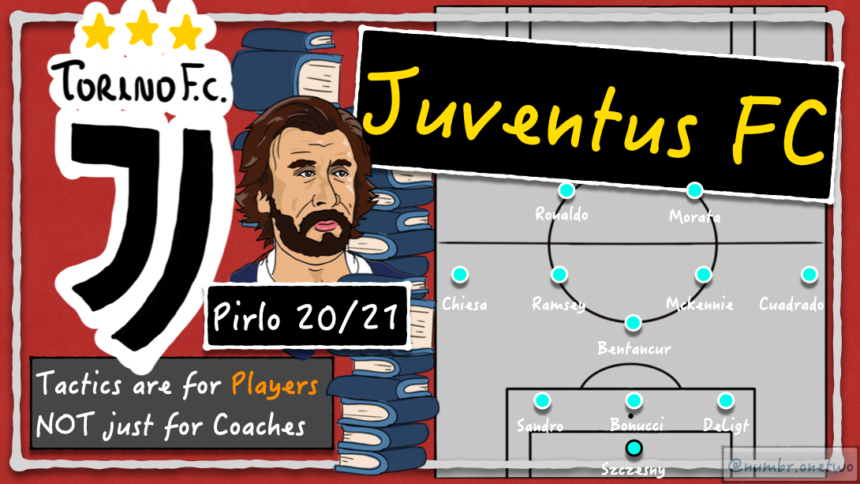Andrea Pirlo has taken over a talented Juventus side. He has critical finishers up front in CR7 and Alvaro Morata while Paulo Dybala is always on the stand by, to step in if either of the two are unavailable (somewhat surprising since he was Serie A’s MVP last season). Alternatively, he can play a slightly deeper supporting role by using his creativity to his advantage.
His midfield is also full of talent. The fact that new signing Arthur, who transferred from FC Barcelona at the beginning of the season has spent much of his time at Juventus on the bench suggests how much competition there is within the team. Rabiot, Bentancur, Ramsey and Mckennie are some of the other big names that start regularly in the central positions.
Of course the wide players cannot be forgotten, and Pirlo in particular, likes quick and creative individuals who can create on their own if necessary. Chiesa and Cuadrado provide Pirlos’ side with much of the attacking power required, while fullbacks Danilo and Sandro have also been able to prove their qualities in both attack and defence.
Pirlos defence is a mixture of old and new talent. Veterans Bonucci and Chiellini are leaders both on and off the pitch while De Ligt is arguably one of the best young centerbacks in the world at the moment, definitely one of the most exciting and full of potential.
This Season Pirlo has alternated between 442 and 352 variations. The depth of his squad has allowed him to be flexible with his personnel. More recently he seems to prefer starting his matches in a 442.


The base of Pirlos’ side, which are the individual qualities of his players are important in understanding his tactics, particularly because he at times, employs players in unorthodox positions. One example which we will look deeper into is the use of Aaron Ramsey, a natural central player in the wide left position. In order to understand his football better it is useful to look at the graduation thesis that he wrote in 2019 for the UEFA pro license.
In his thesis Pirlo names some basic principles that give us an idea of how he wants his teams to play.
Pirlos’ Basic Principles
Player has time on the ball Teammates move away to create space
Player dribbles forward until opposition players come closer – prepare for a one-twoPlayer on the ball is under pressure Teammates come closer to provide an immediate passing option
Additionally, he also describes what he calls his Macro Principles.
Macro Principles
Maximum Width No more and no less than one player on each wing Look to Finish A constant search for opportunities to shoot Depth Always stretch the opposition with runs in behind the defence
In addition, Pirlo organizes his players to form a Rhombus shape. Ideally the vertex of this rhombus should be behind the immediate line of opposition pressure to provide progressive passing options.

From these principles we can see that Pirlo wants to base his football on a possession based style of play with a clearly defined structure of short combinations while stretching the opposition by leaving a player on each of the wings.
This works particularly well with a 3 man build up which he often reverts to, regardless of if he starts the match in a 352 or a 442. When starting the match in a 352, player roles are relatively simple. Each of the wingbacks take positions out wide and the rest congest the centre.
One interesting shape is when he begins the match in a 442. Depending on the players he has available, Pirlo is not afraid to switch things up, particularly with the players he puts out wide. Aaron Ramsey, for example, is one player who, despite being a natural central midfielder, starts at times on the wing for Pirlo in a 442. In possession of the ball, Ramsey tucks inside to allow the fullback to take up the wide areas. This allows Ramsey to play a pivotal role in bridging the attacking players with the defensive players, but also allows him to play in his preferred area of the pitch. Moreover these rotations make it difficult for the opposition to mark.

On defence, Pirlo likes his side to initially press aggressively, particularly after losing the ball. Since Pirlo’s football is possession-based, there are generally many players around the ball for short combinations in attack, but also many players close-by when they lose possession. This makes an immediate press a good option after a loss of possession in a style perfected by the Barcelona side of 2011.
If the opposition are able to stay in possession for longer periods of the match, Pirlo’s sides drop to form compact blocks at the back. This style of defending also varies depending on the personnel he has available at the time. For example, we have also seen him come out of this formation to form a 433 when pressing higher up.


Pirlo is one of the many ex legends who have recently moved to a coaching career. His coaching philosophy is well defined and he seems to be more of a coach of principle and details, rather than a charismatic motivator as can be said for other ex professionals.
We also have a Tactical analysis of Pirlos’ Juventus 20/21 (Video) on our Youtube Channel, with some additional points if you are interested.



Leave a Reply